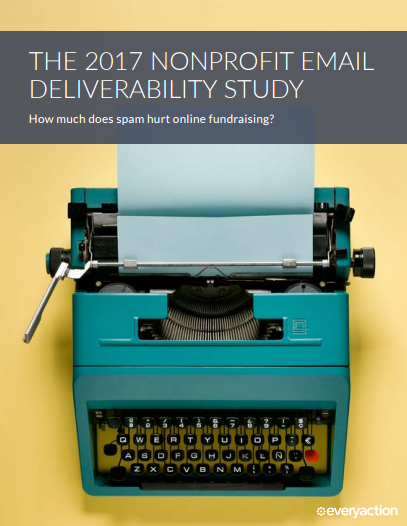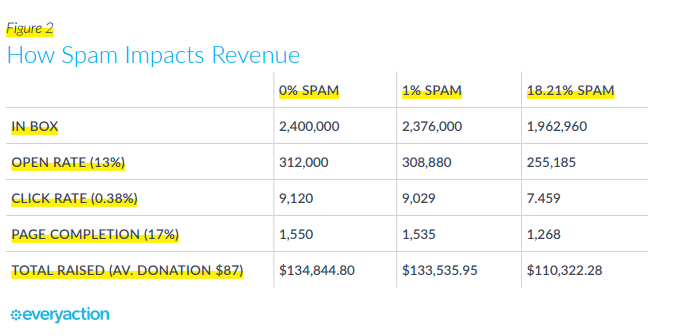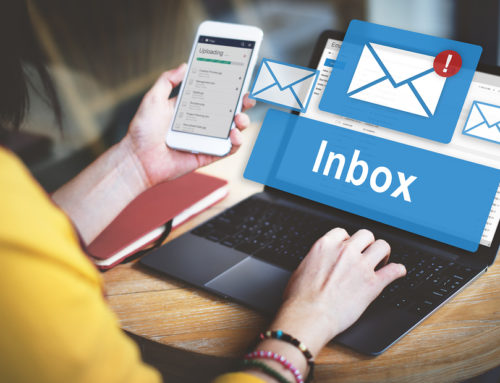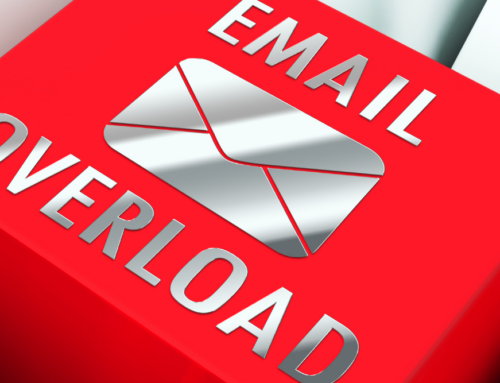 EveryAction just released their annual Email Deliverability Study which answers that exact question.
EveryAction just released their annual Email Deliverability Study which answers that exact question.
Let’s start with a few basics about email deliverability, and then we’ll break down the report.
Email deliverability measures how successful an email is at making it into a recipient’s inbox.
What determines your email deliverability? Many factors really, that are constantly changing, but here are a few:
- Content
- Spam software
- Blacklists
- IP reputation
- Domain reputation
- Traffic
- Speed of delivery
- Recipients themselves
For their report, EveryAction studied 55 organizations and found that, on average, 18.21% of email was delivered to spam folders every month in 2016.
They took a closer look at active fundraising periods and found end-of-year email fundraising took an especially big hit with spam rates jumping to 23.61% in 2016 as opposed to 8.6% for year-end fundraising in 2015.
#GivingTuesday 2016 also saw spam rates climb 9.27% over 2015’s rates.
Read more about spam rates for year-end fundraising and #GivingTuesday in the full study.
What does that mean for your organization?
The chart below from the report is based on an email list of 100,000 people sending 24 fundraising messages annually. Then it breaks down how different spam rates affect your fundraising results using average email stats from the M+R Benchmark Study:

Download the full report: https://act.everyaction.com/email-deliverability-study-2017
You can see that high spam rates cost nonprofits a lot of money – up to $24,500 a year.
So why would you be marked as spam?
Common Causes of Spam
- Unsubscribing is hard. If you make it too difficult for someone to remove themselves from your email list, they will more than likely just mark you as spam.
- Old email lists. Email addresses change all the time, and if you haven’t cleaned up your list in a while, you are lowering your open rates (and your sender reputation) by having those old email addresses.
- Irrelevant content. Segmenting your email list can help with this issue, but sometimes you’re just sending emails with content no one cares about. Think about what your readers would like to hear about from you. Use our 6 Rs of Relevant Messaging checklist to help.
- Lots of complaints. This one sort of speaks for itself. The more people mark you as spam, the higher your spam rate will be, and the fewer emails you have delivered.
What can you do to improve deliverability?
- Opt-in and confirm. When someone signs up for your email list, send a confirmation email. They more confirmed emails you have on your list, the better your deliverability.
- Create a welcome series. How your subscribers react to this series is a good indication of how they will react to other emails you send. If they don’t open the welcome series emails, chances are low they will open anything else either.
- Test your emails. Find out what works best for your list by testing subject lines, calls to action, and other content.
- Track these metrics. Start tracking subscribers who are actually engaged with your emails and get rid of your inactives like we have started doing. You also want to look at bounces and remove anyone who has bounced more than 2 or 3 times.
- Talk to your email provider. Every email service provider is different. Get in touch with someone at your ESP who can tell you more about their procedures to improve deliverability.
Learn more about email deliverability and how you can improve it by downloading your copy of the 2017 Email Deliverability Study from EveryAction and register for their free webinar on May 31st.





